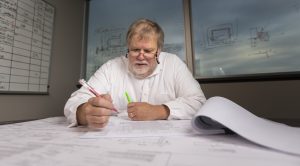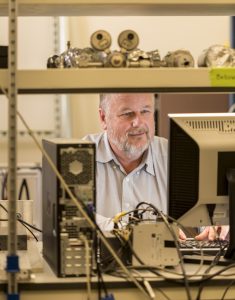UW Department of Ophthalmology and Visual Sciences offers a new, state-of-the-art option for cataract surgery, the femtosecond laser. This device is the next step in providing precision care to patients with cataracts. The femtosecond laser technology is now available for UW Health patients who have their cataract surgery at Madison Surgery Center.
Cataracts are a natural part of aging. With their development, the lens inside the eye becomes cloudy, affecting color vision, night driving and sharp focus. The surgery is common and carries few risks and most patients benefit immediately with a noticeable improvement in their quality of life.
The surgery involves making small incisions into the eye, removing the cloudy lens using ultrasound power and water. The intraocular replacement lens is inserted through the same incision.
The femtosecond laser can be used to perform parts of the cataract surgery which sometimes can result in bladeless surgery. “This really is the most precise tool for removing cataracts,” said Daniel Knoch, MD, who has performed more than 100 cataract surgeries using the femtosecond laser at the William S. Middleton Memorial Veterans Affairs Hospital in Madison. “For appropriate patients, this is an excellent tool,” he said. “The investment in the technology and the tool is another reason we provide remarkable care every day.”
Heather Potter, MD, another cataract surgeon on the UW Health team agrees. “The femtosecond laser is the latest technology in our tech-savvy world,” Potter said. “It is as far as you can go with cataract surgery right now, and I am excited we are there.“

It is the accuracy and the precision of the femtosecond laser that led Todd, 60, of Madison, to wait for the laser to be in place before he had his cataract surgeries. When Todd’s surgeon, Dr. Potter, recommended the femtosecond laser for his procedure, he wanted to do the research before he agreed. An eyeglass wearer since age six, Todd elected to have astigmatism-correcting toric lenses implanted. “I am a structural engineer, and good vision is very important,” Todd said. “I appreciate accuracy and precision, but they mean different things. What I saw with the femtosecond laser was something that is very accurate and very precise.”
“Using the femtosecond allows for a perfect opening in the capsule,” Dr. Potter said. “There are times when we won’t use the laser, if a patient is not an appropriate candidate,” she said. “But for many people, especially people who have mild astigmatism or who are having specialty lenses implanted, the femtosecond is a terrific option.” The laser can help correct astigmatism during the procedure. It also can help make the incisions for a premium intraocular lens that corrects for astigmatism. As a result, patients are often able to get back to enjoying their activities sooner after this bladeless surgery.
The femtosecond laser does have a higher cost. However, in cases where Medicare or other insurance pays for a cataract procedure, the out-of-pocket cost can be minimal for the patient. “This is an important consideration for many of our patients, and we talk carefully about the advantages for each person, and whether this is the best method for them,” Dr. Potter said.

Thomas Mackie, 61, of Middleton, a patient of Dr. Knoch, was diagnosed with a fast-forming type of cataracts in both eyes earlier this year. Mackie described how he had been severely nearsighted since he was twelve years old. Having spent his career in the medical device industry, Mackie felt very comfortable with the concept of high-tech medicine. “When Dr. Knoch told me about the precision of the femtosecond laser, I knew I was the right candidate for the surgery. I understood that the extraction of my damaged lenses would be more efficient and reliable,” Mackie said.
During his femtosecond laser surgery earlier this year, Dr. Knoch implanted a regular lens in one of Mackie’s eyes and an astimagtism-correcting toric lens in the other. A lifelong glasses wearer, Mackie now only needs glasses for reading. “I know how medicine often improves by quantum leaps,” Mackie said. “And it is nice to know that UW is leading the charge with new technology.”
Knoch sees having the latest technologies on-hand as a double bonus. “As a teacher, having this technology available for our residents means no matter where they practice, they are trained using state-of-the-art technology,” Dr. Knoch said. “And as a physician, I know I’m giving my patients the best care available.”